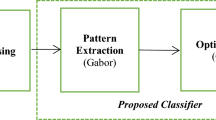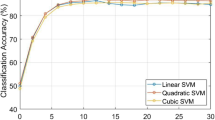Abstract
In this paper, a novel approach is proposed for classification of pulse amplitude modulated (PAM) and quadrature amplitude modulated (QAM) signals. The automatic modulation classification is the intermediate step between detection and demodulation of the signal. In this paper, we propose a classifier for digital modulated signals such as PAM and QAM that differs with the existing classifiers. The gabor parameters have been used as input features and the proposed classifier uses hidden markov model in conjunction with genetic algorithm (GA). The fitness function for the genetic algorithm is probability of observation sequence given the model. The objective is to maximize the probability of observation using Baum–Welch algorithm and GA. To improve the classification accuracy, classification process has been divided in two phases. Simulation results shows the significant performance improvement while compare with other existing techniques.






Similar content being viewed by others
References
Azzouz, E. E., & Nandi, A. K. (1996). Automatic modulation recognition of communication signals. Kluwer Academic Publishers.
Nandi, A. K., & Azzouz, E. E. (1998). Algorithms for automatic modulation recognition of communication signals. IEEE Transactions on Communications, 46, 431–436.
Ramkumar, B. (2009). Automatic modulation classification for cognitive radios using cyclic feature detection. IEEE Circuits and Systems Magazine, 9, 27–45.
Dobre, O. A., Abdi, A., Bar-Ness, Y., & Su, W. (2007). A survey of automatic modulation classification techniques: classical approaches and new trends. IET Communication, 1, 137–156.
Sue, W., Jefferson, L. X., & Mengchou, Z. (2008). Real-time modulation classification based on maximum likelihood. IEEE Communications letters, 12(11), 781–784.
Yang, Y., Chang, J. N., Liu, J. C., & Liu, C. H. (2007). Maximum log-likelihood function based QAM signal classification over fading channel. Wireless Personal Communications, 28, 77–94.
Panagiotou, P., Anastasopoulos, A., & Polydoros, A. (2000). Likelihood ratio tests for modulation classification. In Proceedings of the IEEE MILCOM, vol. 2, (pp. 670–674).
Hameed, F., Dobre, O., & Popescu, D. (2009). On the likelihood based approach to modulation classification. IEEE Transactions on Wireless Communication, 8(12), 5884–5892.
Ramezani Kebrya, A., Kim, I.-M., Kim, D. I., Chan, F., & Inkol, R. (2013). Likelihood based modulation classification for multiple antenna receiver. IEEE Transactions on Communications, 61(9), 3816–3829.
Sergienko, A. B., & Osipov, A. V. (2014). Digital modulation recognition using circular harmonic approximation of likelihood function. In IEEE international conference on acoustic, speech and signal processing (ICASSP), (pp. 3460–3463).
Zhu, Z., & Nandi, A. K. (2014). Blind digital modulation classification using minimum distance centroid estimator and non-parametric likelihood function. IEEE Transactions on Wireless Communication, 13(8), 4483–4494.
Lin, Y. C., & Jay Kuo, C. C. (1997). Classification of quadrature amplitude modulated (QAM) signals via sequential probability ratio test (SPRT). Signal Processing, 60, 263–280.
Soltan Mohammadi, E., & Naraghi Pour, M. (2013). Blind modulation classification over fading channels using expectation maximization. IEEE Communication Letters, 17(9), 1692–1695.
Wei, Su, Xu, Jefferson L., & Zhou, Mengchu. (2008). Real time modulation classification based on maximum likelihood. IEEE Communication Letters, 12(11), 801–803.
Xu, Jefferson L., Wei, Su, & Zhou, Mengchu. (2010). Software defined radio equipped with rapid modulation recognition. IEEE Transactions on Vehicular Technology, 59(4), 1659–1667.
Ghauri, S. A., Qureshi, I. M., Malik, A. N., & Cheema, T. A. (2014). Automatic digital modulation recognition technique using higher order cummulants on faded channels. Journal of Basic and Applied Scientific Research, 4(3), 1–12.
Ghauri, S. A., Qureshi, I. M., Cheema, T. A., & Malik, A. N. (2014). A Novel Modulation Classification Approach Using Gabor Filter Network. Cairo: The World Scientific Journal, Hindwai Publishers.
Ghauri, S. A., Qureshi, I. M., Malik, A. N., & Cheema, T. A. (2013). Higher order cummulants based digital modulation recognition scheme. Research Journal of Applied Sciences Engineering and Technology (RJASET), 6(20), 3910–3915.
Ahmadi, Negar. (2011). Modulation recognition based on Constellation shape using TTSAS algorithm and template matching. Journal of Pattern Recognition Research, 1, 43–55.
He, Tao, & Zhou, Zheng-Ou. (2008). Classification of modulated signals using multifractal features. Journal of the Chinese Institute of Engineers, 31(2), 335–338.
Aslam, M. W., Zhu, Z., & Nandi, A. K. (2012). Automatic modulation classification using combination of Genetic programming and KNN. IEEE Transaction on Wireless Communication, 11(8), 2742–2750.
Puengnim, A., Thomas, N., Tourneret, J. Y., & Vidal, J. (2010). Classification of linear and nonlinear modulation using the Baum–Welch algorithms and MCMC methods. Signal Processing, 90(12), 3342–3355.
Dulek, B., Ozdemir, O., Varshney, P. K., & Su, W. (2014). A novel approach to dictionary construction for Automatic modulation classification. Journal of the Franklin Institute, 351, 2991–3012.
Dobre, O. A., Abdi, A., Bar Ness, Y., & Su, W. (2010). Cyclostatoinarity based modulation classification of linear digital modulations in flat fading channels. Wireless Personal Communication, 54, 699–717.
Swami, A., & Sadler, B. (2000). Hierarchical digital modulation classification using cummulants. IEEE Transactions on Communication, 48(3), 416–429.
Liu, P., & Shui, P. L. (2014). Digital modulation classifier with rejection ability via greedy convex hull learning and alternative convex hull shrinkage in feature space. IEEE Transaction on Wireless Communication, 13(5), 2683–2695.
Su, W. (2013). Feature space analysis of modulation classification using very higher order statistics. IEEE Communication Letters, 17(9), 1688–1691.
Kharbech, S., Dayoub, I., Zwingelstein Colin, M., Simon, E. P., & Hassan, K. (2014). Blind digital modulation identification for time selective MIMO channels. IEEE Wireless Communication Letters, 3(4), 373–376.
Marey, M., & Dobre, O. A. (2014). Blind modulation classification algorithm for single and multiple antenna systems over frequency selective channels. IEEE Signal Processing Letters, 21(9), 1098–1102.
Avci, E., Hanbay, D., & Varol, A. (2007). An expert discrete wavelet adaptive network based fuzzy inference system for digital modulation recognition. Expert System with Applications, 33, 582–589.
Shi, Q., Gong, Y., & Guan, Y. L. (2011). Modulation classification for asynchronous high-order QAM signals. Wireless Communications and Mobile Computing, 11, 1415–1422.
Dobre, O. A., Bar-Ness, Y., & Su, W. (2003). Higher-order cyclic cummulants for high order modulation classification. In Proceedings of the 2003 IEEE MILCOM, (pp. 112–117).
Xi, S., & Wu, H. C. (2006). Robust automatic modulation classification using cummulants features in the presence of fading channels. IEEE Wireless Communication and Networking Conference, 4, 2094–2099.
Wu, H., Saquib, M., & Yun, Z. (2008). Novel automatic modulation classification using cumulant features for communications via multipath channels. IEEE Transactions on Wireless Communications, 7, 3098–3105.
Chaithanya, V., & Reddy, V. U., (2010). Blind modulation classification in the presence of carrier frequency offset. In Proceedings of the 2010 international conference on signal processing and communications, (pp. 1–5).
Puengnim, A., Thomas, N., Tourneret J. Y., & Vidal, J. (2007). Hidden markov models for digital modulation classification in unknown ISI channels. In 15th European signal processing conference, (pp. 1882–1886).
Mirrarab, M. R., & Sobhani, M. A., Robust modulation classification for PSK/QAM/ASK using higher order cummulants. In International conference on information, communications and signals, (pp.1–4).
Author information
Authors and Affiliations
Corresponding author
Rights and permissions
About this article
Cite this article
Ghauri, S.A., Qureshi, I.M. & Malik, A.N. A Novel Approach for Automatic Modulation Classification via Hidden Markov Models and Gabor Features. Wireless Pers Commun 96, 4199–4216 (2017). https://doi.org/10.1007/s11277-017-4378-x
Published:
Issue Date:
DOI: https://doi.org/10.1007/s11277-017-4378-x





